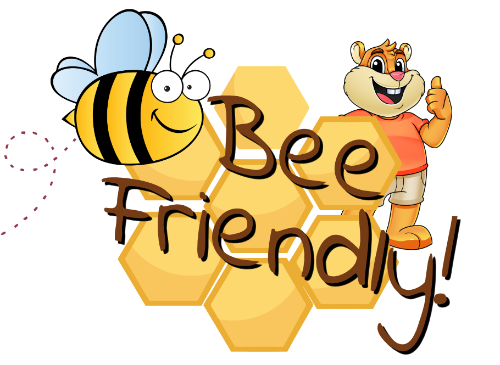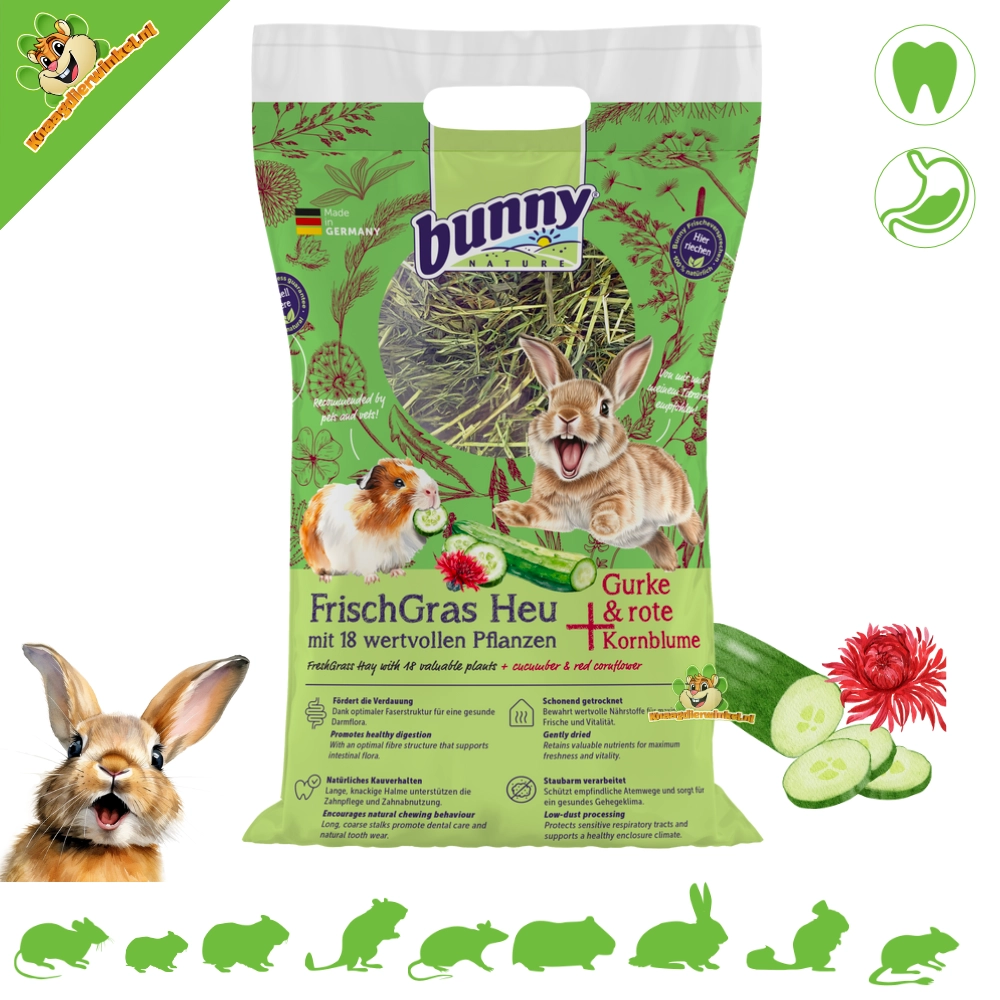Have a question?
Have a question about this product? Please feel free to contact us, we will be happy to help you!
Have a question about this product? Please feel free to contact us, we will be happy to help you!

Hay is a staple food for many rodents. The high hay content in their digestive system makes the quality of the hay crucial. It's crucial for acceptance, but also for nutritional balance and complete coverage of their needs. BunnyNature Fresh Grass Hay represents the highest quality with maximum plant diversity.
Bunny Nature FreshGras Hay isn't just any hay. It's premium hay of the highest quality! It's good to know that the hay is dried indoors and packed by hand. While it may seem time-consuming at first, this is the only way to separate harmful plant species that come along during the harvest. Furthermore, hand-packing ensures beautiful, long hay stalks that retain their maximum nutritional value. A hay stalk that's been used frequently loses essential nutrients.
✔ Natural plant diversity
✔ Gentle drying indoors
✔ Rich in fiber, crunchy & low in dust
✔ With natural nutrients and fiber
Bunny Hay's guidelines are strict. The hay must be high in fiber, crisp, and naturally dust-free. Hay that doesn't meet these requirements will not be included in the packaging. Crisp hay is important for good dental wear and healthy gastrointestinal function in animals.
The ingredients are impressive! The hay is made from no fewer than 18 different plant species.
Timothy, Meadow Fescue, Meadow Foxtail, Ryegrass, Red Fescue, Meadow Grass, Bent Grass, Cocksfoot, German Meadow Grass, Dandelion, Silverweed, Hornwort, Yarrow, Ribwort Plantain, White Clover, Red Clover, Bird's-foot Trefoil, Red Fescue with strong runners.
This is the most original and natural hay imaginable. Naturally, the hay comes from protected nature reserves: these unfertilized and unsprayed areas are home to a diversity of plants and herbs that no other ordinary meadow can match.
But even nature-protected meadows need to be mown occasionally (at a late mowing time), because that is the only way to preserve the diversity of plants and thus the attractive character of the meadows for animals.
And this is all part of the bunny sustainability cycle: We mow the nature-protected meadows so that animals can still find their valuable food and thus get hay that is unique in terms of quality, composition and structure.
After mowing, the hay—now pressed into bales—undergoes a so-called "wellness treatment." The hay is gently dried with warm air, a process that is CO2-neutral and completely in harmony with nature. This preserves, among other things, the natural color, the diverse flavor, and the abundance of fine herbs and plants. It's unique!
Regular mowing is important to maintain plant diversity. Without it, a monoculture would develop. Only a few plant species would become established, and diversity would disappear. These meadows are unattractive to many animals, neither as a habitat nor as a food source. Therefore, we actively work to keep these natural habitats attractive to animals in every way. We only start mowing from mid-June onwards, so as not to disturb any breeding animals. Protected meadows are supervised by experts who officially authorize mowing.
Here, craftsmanship is still highly valued. The hay is carefully shaken, and all the finest plants and herbs—as well as the long, crisp stalks—are meticulously placed by hand in paper bags. The hay fresh-bags are quite special: only through a small window can you see the fantastic hay, giving you a good impression of its quality. Moreover, this protects the contents from fading, and the fine holes allow for ideal air circulation. The hay is optimally stored and retains its original quality in the racks.
We ensure that our hay remains UV-free!
At DRD Rodent Shop®, we store our hay in a dark, cool place, away from sunlight and UV rays. Why is that important? UV light can affect the quality of hay by breaking down nutrients and colorants. Thanks to our specialized storage, we ensure that the aroma, color, and nutritional value are perfectly preserved.
Hay is a natural nesting material for small rodents and an essential source of fiber for larger rodents and rabbits!
![]() Small rodents like mice, dwarf hamsters, hamsters, and gerbils like to build nests out of hay. Small rodents have a much lower fiber requirement, but if a fiber deficiency occurs or their needs are temporarily higher, they'll happily nibble on hay. This means hay serves two purposes for small rodents!
Small rodents like mice, dwarf hamsters, hamsters, and gerbils like to build nests out of hay. Small rodents have a much lower fiber requirement, but if a fiber deficiency occurs or their needs are temporarily higher, they'll happily nibble on hay. This means hay serves two purposes for small rodents!
![]() Hay is essential for guinea pigs, rabbits, chinchillas, and degus. These animals should receive unlimited hay daily to maintain healthy intestinal function.
Hay is essential for guinea pigs, rabbits, chinchillas, and degus. These animals should receive unlimited hay daily to maintain healthy intestinal function.
![]() Hay is perfect for hamster scaping! Mix the hay with your own bedding or layer it, alternating the hay and bedding. This makes the bedding more durable and helps preserve the tunnels made by the small rodents. The hay also has a beautiful visual effect; the varying colors give the enclosure a very natural look.
Hay is perfect for hamster scaping! Mix the hay with your own bedding or layer it, alternating the hay and bedding. This makes the bedding more durable and helps preserve the tunnels made by the small rodents. The hay also has a beautiful visual effect; the varying colors give the enclosure a very natural look.
| Content (approx): | 500 grams |
| Composition: | - |
| Analysis: | - |
| Promotes Foraging: | Yes |
| Suitable for: | Rodents, Mouse, Dwarf Hamster, Hamster, Gerbil, Rat, Guinea Pig, Rabbit, Chinchilla, Degus |
| Type: | supplementary pet food |
| Particularities: | - |
| Disclaimer: | Not for food producing animals |
